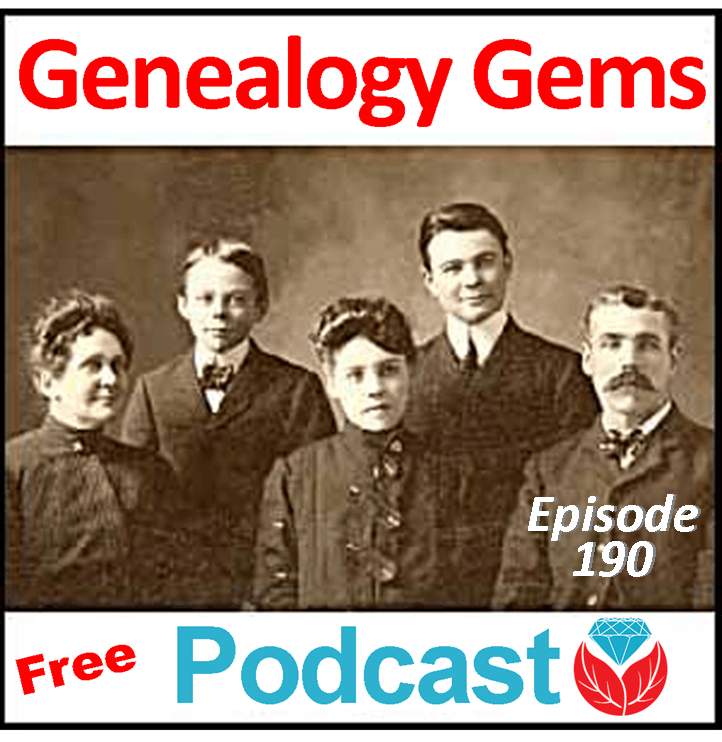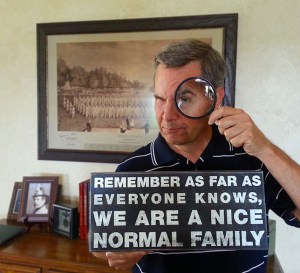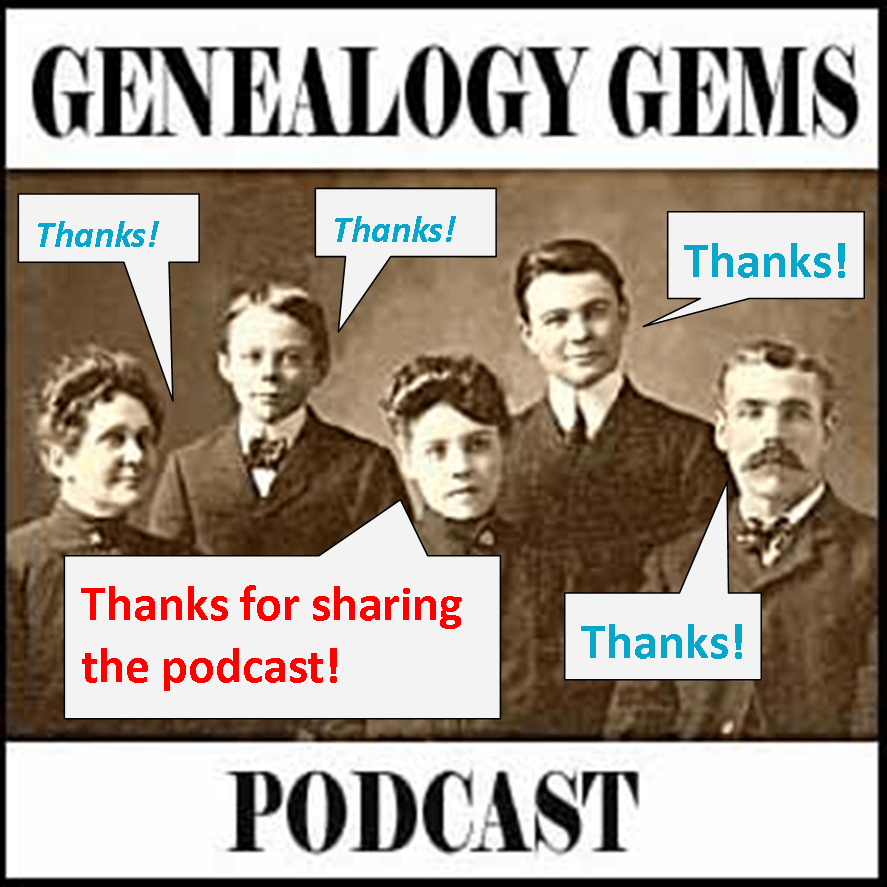We Dig These Gems: New Genealogy Records Online
 We learn about so many fantastic new genealogy records online every week. So each Friday we round up several of them for you to glance through. Watch for databases and documents that your ancestors might appear in–but also watch for the kinds of records that may be out there already, that you haven’t yet looked for. This week: British women in World War I, Polish-American marriages, Irish vital records, Canadian travel photography, Scottish artifacts and documents and a Louisiana (US) press archive.
We learn about so many fantastic new genealogy records online every week. So each Friday we round up several of them for you to glance through. Watch for databases and documents that your ancestors might appear in–but also watch for the kinds of records that may be out there already, that you haven’t yet looked for. This week: British women in World War I, Polish-American marriages, Irish vital records, Canadian travel photography, Scottish artifacts and documents and a Louisiana (US) press archive.
WWI WOMEN. FindMyPast has posted over 9,500 UK records that illustrate the various roles played by woman during the Frist World War. These include:
- Women’s Army Auxiliary Corps Service Records 1917-1920. It’s a relatively small collection but rich in material on each woman.
- British Women’s Royal Naval Service officer files 1917-1919 (ADM 318) details the service history of women who served as officers in the Women’s Royal Naval Service during the First World War.
- British Women’s Royal Naval Service Ratings’ Service Registers 1918-1919 contains the details of nearly 7,000 enlisted women who served as Wrens during the First World War.
- British Women’s Royal Air Force Service Records 1918-1920 is an index of 31,090 Women’s Royal Air Force service records held by The National Archives.
POLISH-AMERICAN MARRIAGES. A new database of Polish-American marriages has been posted by the Polish Genealogical Society of Connecticut and the Northeast.
According to a press release, “This database contains the names of couples of Polish origin who were married in select locations in the Northeast United States. The information was taken from marriage records, newspaper marriage announcements, town reports, parish histories or information submitted by Society members. The time period generally covered by these lists is 1892-1940. It includes the States of Delaware, Massachusetts, New Hampshire, New Jersey, Rhode Island and Vermont. Connecticut and Jersey City, NJ will be added at a later date.”
IRISH BMD. Over a million records appear in a new database of Irish records of the city and county of Derry~Londonderry and Inishowen, County Donegal. Entries span 1642-1922 and include:
- Pre-1922 civil birth and marriage registers,
- Early baptismal and marriage registers of 97 churches,
- Headstone inscriptions from 118 graveyards, and
- Census returns and census substitutes from 1663 to 1901.
Click here to access these records (and other County Derry resources) at RootsIreland,ie (subscription required).
CANADIAN TRAVEL PHOTOGRAPHY. A small but visually rich collection of pictures promoting Canadian tourism is now at Flickr Creative Commons. Use these to explore places your ancestors may have visited (and the images that may have lured them there) if they vacationed by rail in the 1800s or early 1900s. (Click here to learn more about finding great historical photos at Flickr Creative Commons.)
SCOTTISH ARTIFACTS AND DOCUMENTS. A new digital archive at Historic Scotland has launched an online database of 400 artefacts now includes over 400 artifacts important to Scottish history. Everyday household objects, ship models, coins, weaponry, bits ‘n bobs of old homes and buildings, industrial machinery and miscellaneous photos, books and ephemera are all browsable on this site. It’s a great place to look for images that help illustrate your Scottish ancestors’ history.
LOUISIANA PRESS COVERAGE. The Louisiana Digital Media Archive has launched as “the first project in the nation to combine the media collections of a public broadcaster and a state archives,” according to its site description. “This ever-expanding site contains a combined catalog of thousands of hours of media recorded over the past half-century. You can see interviews with Louisiana civil rights pioneers, notable political figures, war heroes, artists and literary icons. You’ll have a front row seat to Louisiana history through video of historic events. You can also visit remote and endangered Louisiana places and cultures.”
 Not sure how to find record sets like these for YOUR family history? Here’s a tip! Set up a Google Alert. Say you want to know whenever new material on Polish-Americans in Detroit is found by Google’s ever-searching search engines. Click here to learn how to set up this search (or any other) Google Alert for genealogy.
Not sure how to find record sets like these for YOUR family history? Here’s a tip! Set up a Google Alert. Say you want to know whenever new material on Polish-Americans in Detroit is found by Google’s ever-searching search engines. Click here to learn how to set up this search (or any other) Google Alert for genealogy.
This tip comes to you courtesy of the book The Genealogist’s Google Toolbox, Second Edition by Lisa Louise Cooke–the fully-revised 2015 edition that’s packed with strategies that will dramatically improve your ability to find your family history online.
Privacy Policy
GENEALOGY GEMS found at https://www.lisalouisecooke.com/ (“Website”) is governed by the following privacy policy (“Privacy Policy”).
We respect your privacy and are committed to protecting it. The purpose of this Privacy Policy is to inform you what personally identifiable information we may collect and how it may be used. This statement only applies to this Website.
WHAT INFORMATION DO WE COLLECT AND HOW IS IT USED?
Information You Voluntarily Submit to the Website: We may collect personal information from you such as your name or email address. For example, you may voluntarily submit information to the Website by leaving a comment, subscribing to a newsletter, or submitting a contact form. In addition, you are able to create a user profile, which allows you to create a username and password. We will store the username, but your password will not be visible in our records.
Automatically-Collected Information: We automatically collect certain information about you and the device with which you access the Website. For example, when you use the Website, we will log your IP address, operating system type, browser type, referring website, pages you viewed, and the dates/times when you accessed the Website. We may also collect information about actions you take when using the Website, such as links clicked.
Cookies: We may log information using cookies, which are small data files stored on your browser by the Website. We may use both session cookies, which expire when you close your browser, and persistent cookies, which stay on your browser until deleted, to provide you with a more personalized experience on the Website.
HOW YOUR INFORMATION MAY BE USED
We may use the information collected in the following ways:
- To operate and maintain the Website;
- To create your account, identify you as a user of the Website, and customize the Website for your account;
- To send you promotional information, such as newsletters. Each email promotion will provide information on how to opt-out of future mailings;
- To send you administrative communications, such as administrative emails, confirmation emails, technical notices, updates on policies, or security alerts;
- To respond to your comments or inquiries;
- To provide you with user support;
- To track and measure advertising on the Website;
- To protect, investigate, and deter against unauthorized or illegal activity.
THIRD-PARTY USE OF PERSONAL INFORMATION
We may share your information with third parties when you explicitly authorize us to share your information.
Additionally, the Website may use third-party service providers to service various aspects of the Website. Each third-party service provider’s use of your personal information is dictated by their respective privacy policies.
The Website currently uses the following third-party service providers:
Google Analytics – this service tracks Website usage and provides information such as referring websites and user actions on the Website. Google Analytics may capture your IP address, but no other personal information is captured by Google Analytics.
Constant Contact – this service is used for delivery of email updates and newsletters. We store your name and email address for purposes of delivering such communications. Please refer to Constant Contact’s privacy policy for further information.
At this time, your personal information is not shared with any other third-party applications. This list may be amended from time to time in the Website’s sole discretion.
Except when required by law, we will not sell, distribute, or reveal your email addresses or other personal information without your consent; however, we may disclose or transfer personal information collected through the Website to third parties who acquire all or a portion of our business, which may be the result of a merger, consolidation, or purchase of all or a portion of our assets, or in connection with any bankruptcy or reorganization proceeding brought by or against us.
ANONYMOUS DATA
From time to time, we may use anonymous data, which does not identify you alone, or when combined with data from other parties. This type of anonymous data may be provided to other parties for marketing, advertising, or other uses. Examples of this anonymous data may include analytics or information collected from cookies.
PUBLICLY VISIBLE INFORMATION
If you create a user profile on the Website or leave a comment, certain information may be publicly visible. To create a user profile, you must choose a username and password and input your email address for profile confirmation. Your email address will never be available publicly. At your option, you may also add an avatar, a profile description, and a link to your website.
Users may see your username, avatar, profile description and website information.
COOKIES
The Website uses cookies to store visitors’ preferences, record user-specific information on what pages users access or visit, ensure that visitors are not repeatedly sent the same banner ads, customize Website content based on visitors’ browser type or other information that the visitor sends. Cookies may also be used by third-party services, such as Google Analytics, as described herein.
Users may, at any time, prevent the setting of cookies, by the Website, by using a corresponding setting of your internet browser and may thus permanently deny the setting of cookies. Furthermore, already set cookies may be deleted at any time via an Internet browser or other software programs. This is possible in all popular Internet browsers. However, if users deactivate the setting of cookies in your Internet browser, not all functions of our Website may be entirely usable.
ADVERTISING
Affiliate Program Participation
The Website may engage in affiliate marketing, which is done by embedding tracking links into the Website. If you click on a link for an affiliate partnership, a cookie will be placed on your browser to track any sales for purposes of commissions.
Genealogy Gems is a participant in the Amazon Services LLC Associates Program, an affiliate advertising program designed to provide a means for sites to earn advertising fees by advertising and links to Amazon.com. As part of this Amazon Associates program, the Website will post customized links, provided by Amazon, to track the referrals to their website. This program utilizes cookies to track visits for the purposes of assigning commission on these sales.
Newsletters
On the Website, you may subscribe to our newsletter, which may be used for advertising purposes. All newsletters sent may contain tracking pixels. The pixel is embedded in emails and allows an analysis of the success of online marketing campaigns. Because of these tracking pixels, we may see if and when you open an email and which links within the email you click. Also, this allows the Website to adapt the content of future newsletters to the interests of the user. This behavior will not be passed on to third parties.
RIGHTS RELATED TO YOUR PERSONAL INFORMATION
Opt-out – You may opt-out of future email communications by following the unsubscribe links in our emails. You may also notify us at service@genealogygems.com to be removed from our mailing list.
Access – You may access the personal information we have about you by submitting a request to service@genealogygems.com.
Amend – You may contact us at service@genealogygems.com to amend or update your personal information.
Forget – In certain situations, you may request that we erase or forget your personal data. To do so, please submit a request to service@genealogygems.com.
Please note that we may need to retain certain information for recordkeeping purposes or to complete transactions, or when required by law.
SENSITIVE PERSONAL INFORMATION
At no time should you submit sensitive personal information to the Website. This includes your social security number, information regarding race or ethnic origin, political opinions, religious beliefs, health information, criminal background, or trade union memberships. If you elect to submit such information to us, it will be subject to this Privacy Policy.
CHILDREN’S INFORMATION
The Website does not knowingly collect any personally identifiable information from children under the age of 16. If a parent or guardian believes that the Website has personally identifiable information of a child under the age of 16 in its database, please contact us immediately at service@genealogygems.com and we will use our best efforts to promptly remove such information from our records.
Mediavine Programmatic Advertising (Ver 1.1)
The Website works with Mediavine to manage third-party interest-based advertising appearing on the Website. Mediavine serves content and advertisements when you visit the Website, which may use first and third-party cookies. A cookie is a small text file which is sent to your computer or mobile device (referred to in this policy as a “device”) by the web server so that a website can remember some information about your browsing activity on the Website.
First party cookies are created by the website that you are visiting. A third-party cookie is frequently used in behavioral advertising and analytics and is created by a domain other than the website you are visiting. Third-party cookies, tags, pixels, beacons and other similar technologies (collectively, “Tags”) may be placed on the Website to monitor interaction with advertising content and to target and optimize advertising. Each internet browser has functionality so that you can block both first and third-party cookies and clear your browser’s cache. The “help” feature of the menu bar on most browsers will tell you how to stop accepting new cookies, how to receive notification of new cookies, how to disable existing cookies and how to clear your browser’s cache. For more information about cookies and how to disable them, you can consult the information at All About Cookies.
Without cookies you may not be able to take full advantage of the Website content and features. Please note that rejecting cookies does not mean that you will no longer see ads when you visit our Site. In the event you opt-out, you will still see non-personalized advertisements on the Website.
The Website collects the following data using a cookie when serving personalized ads:
- IP Address
- Operating System type
- Operating System version
- Device Type
- Language of the website
- Web browser type
- Email (in hashed form)
Mediavine Partners (companies listed below with whom Mediavine shares data) may also use this data to link to other end user information the partner has independently collected to deliver targeted advertisements. Mediavine Partners may also separately collect data about end users from other sources, such as advertising IDs or pixels, and link that data to data collected from Mediavine publishers in order to provide interest-based advertising across your online experience, including devices, browsers and apps. This data includes usage data, cookie information, device information, information about interactions between users and advertisements and websites, geolocation data, traffic data, and information about a visitor’s referral source to a particular website. Mediavine Partners may also create unique IDs to create audience segments, which are used to provide targeted advertising.
If you would like more information about this practice and to know your choices to opt-in or opt-out of this data collection, please visit National Advertising Initiative opt out page. You may also visit Digital Advertising Alliance website and Network Advertising Initiative website to learn more information about interest-based advertising. You may download the AppChoices app at Digital Advertising Alliance’s AppChoices app to opt out in connection with mobile apps, or use the platform controls on your mobile device to opt out.
For specific information about Mediavine Partners, the data each collects and their data collection and privacy policies, please visit Mediavine Partners.
CONTACT INFORMATION
At any time, please contact us at service@genealogygems.com for questions related to this Privacy Policy.
Last updated: 2022
What Family Memories are YOU Making this Summer?
My daughter Hannah is an adventurer at heart, and turns drives to genealogy conferences into trips to remember. This summer, be sure to make memories with living relatives! Have a wonderful week! -Lisa About the Author: Lisa Louise Cooke Lisa is the Producer and Host...Genealogy Gems Podcast Episode 190: Missing Person’s Case SOLVED!
 In the just-published, free Genealogy Gems Podcast episode 190, hear from a genealogist who helped lay to rest a 30-year old missing-person’s case–and so much more.
In the just-published, free Genealogy Gems Podcast episode 190, hear from a genealogist who helped lay to rest a 30-year old missing-person’s case–and so much more.
Don’t you love it when everyday heroes help the experts solve baffling mysteries? I especially love it when that hero is a genealogist who wields research skills with deftness, creativity and bulldog tenacity. Has Lisa Louise Cooke got a story for us!

Scott Fisher, Extreme Genes
In the new Genealogy Gems Podcast episode 190, Lisa interviews Extreme Genes radio host Scott Fisher about his now-famous role in helping to solve a 30-year old missing persons case. He’s told this story to People, FoxNews and CBS.com, but here Lisa gets Scott to really lay out the details of how he did it for fellow researchers.
There’s more to love in Genealogy Gems Podcast episode 190, such as:
- Lisa advises a listener on a pesky Gmail problem;
- A whirlwind world tour of new genealogy records online;
- Searching out military service details with Google Books;
- One RootsTech attendee’s Google search success story
- the new Genealogy Gems Book Club title, a brand-new, much-anticipated second novel by a breakout British novelist.
 Click here to listen to the episode for FREE (no membership or login required).
Click here to listen to the episode for FREE (no membership or login required).
Not sure what a podcast is or how to listen? Click here to learn more about these “online radio shows” that you can take with you on your mobile device. Listen while you commute, exercise, do your household chores or garden.

